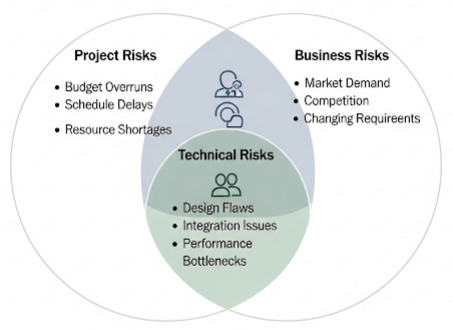- Metrics for Process and Products
- Software measurement
- Metrics for Software Quality
- Risk Management
- Reactive versus Proactive Risk Strategies
- Software Risks
- Risk Identification
- Risk Projection
- Risk Refinement
- RMMM
- RMMM Plan
- Quality Management
- Quality Concepts
- Software Reviews
- Formal Technical Reviews
- Statistical Software Quality Assurance
- Software Reliability
- The ISO 9000 Quality Standards
Introduction to Software Risks
In the realm of software engineering, software risks are inherent uncertainties that could negatively impact a project’s schedule, budget, or the quality of the final software product. A risk is not a problem that has already occurred, but rather a potential problem; it’s an event or condition that, if it occurs, could have a detrimental effect. Understanding and categorizing these potential threats is the foundational step in mitigating them. By identifying the various types of software risks, development teams can better prepare for uncertainties and develop strategies to minimize their adverse effects.
Categories of Software Risks
Software risks can be broadly classified based on their nature and origin. Effective risk management requires an understanding of these different categories to ensure comprehensive coverage.
Project Risks
Project risks are those potential problems that primarily threaten the project plan itself. They are associated with the management and execution aspects of a software development project. These risks can jeopardize the project’s ability to stay on schedule and within budget, or to complete its objectives.
Common examples of project risks include:
- Budgetary Risks: Potential for cost overruns due to inaccurate estimates, scope creep, or unforeseen expenses.
- Schedule Risks: Threats to the project timeline, such as delays in task completion, resource unavailability, or dependency issues.
- Personnel Risks: Challenges related to the development team, including staff turnover, insufficient skills, or difficulties in team collaboration.
- Resource Risks: Problems with the availability or allocation of necessary hardware, software, or tools.
- Customer and Requirements Risks: Issues stemming from unclear, ambiguous, or constantly changing customer requirements, or lack of active customer involvement.
Technical Risks
Technical risks are potential problems that threaten the quality and timeliness of the software to be produced. These risks are inherent in the technological aspects of software development and can impact the functionality, performance, and maintainability of the final product.
Examples of technical risks are:
- Design Risks: Issues arising from poor architectural choices, complex designs, or unproven design patterns that could lead to instability or performance problems.
- Implementation Risks: Challenges during coding, such as integration difficulties, errors in complex algorithms, or the use of unfamiliar programming languages.
- Interface Risks: Problems related to how different software components or external systems interact, potentially leading to data corruption or communication failures.
- Verification Risks: Difficulties in testing the software thoroughly, which could result in undiscovered defects or an inability to confirm compliance with requirements.
- Maintenance Risks: Future challenges in correcting, adapting, or enhancing the software due to poor documentation, convoluted code, or high complexity.
Business Risks
Business risks are potential problems that threaten the viability of the software being built or the business objectives it is meant to support. These risks extend beyond the immediate project execution and can impact the long-term success and value of the software.
Examples of business risks include:
- Market Risk: The possibility of building a product that nobody wants or that fails to meet market demand.
- Strategic Risk: The risk that the software project does not align with the overall business strategy of the organization.
- Sales Risk: Challenges in effectively marketing or selling the developed software.
- Management Risk: The potential for a loss of senior management support or commitment for the project, which can starve it of resources.
Predictability of Software Risks
Beyond categorization by nature, software risks can also be classified based on their predictability:
- Known Risks: These are risks that can be uncovered after a careful evaluation of the project plan, the business and technical environment, and other reliable information sources. They are identifiable through experience and systematic analysis. For instance, if a team previously struggled with a specific technology, that’s a known risk for a new project using it.
- Predictable Risks: These are risks that are extrapolated from past project experiences. They are not always immediately obvious but can be anticipated based on historical data or common industry patterns. For example, a complex integration task is often a predictable risk.
- Unpredictable Risks: These are risks that can occur but are extremely difficult or impossible to identify in advance. They are true unknowns that emerge unexpectedly. While their occurrence cannot be forecasted, effective risk management still involves building resilience to cope with unforeseen challenges.

Conclusion
Understanding the various software risks is fundamental to successful software development. By systematically categorizing these potential problems into project, technical, and business risks, and further classifying them by their predictability (known, predictable, unpredictable), teams gain crucial insights. This comprehensive identification empowers project managers to anticipate challenges, prioritize threats, and proactively develop robust strategies to minimize their impact, ensuring the timely delivery of high-quality software products
